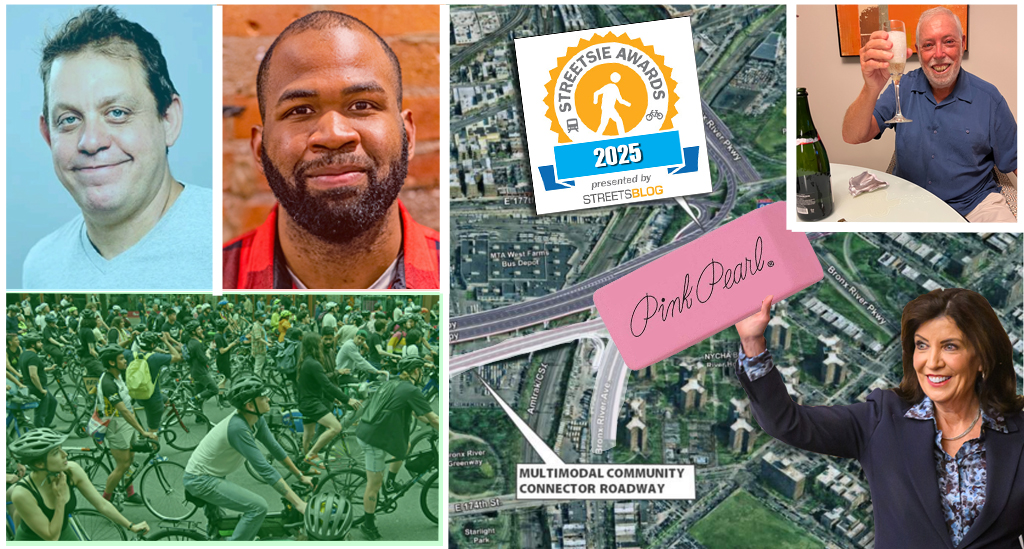Not yet three months old, Occupy Wall Street stands this week on the threshold of its first big concrete win. Governor Andrew Cuomo has called a special session of the New York State Legislature, reportedly to recalibrate the state income tax to draw more from the one or two percent at the top and less from everyone else. After refusing for months to consider extending the state’s “millionaires’ tax,” the governor may have sensed a need to stand with the 99 percent, even if it requires bending a campaign promise.

At this point, it’s fair to ask how the changes in the zeitgeist wrought by the Occupy movement might affect transit and transportation in New York City. Will revenue infusions from Albany mean better service and stable fares for that most egalitarian mode of travel, mass transit? Will the most inefficient and socially destructive mode -- driving private cars into Manhattan -- finally pay for usurping so much street and road space? In particular, might congestion pricing, the sole policy measure that could finance transit and disincentivize driving in gridlock, get a boost from OWS’s paradigm of equity and equality?
All that’s clear at the moment is that little if any new state income tax revenue will go to transit. Any net increase will be too small, while other claimants such as education and medical care are too compelling. New revenues may lessen the chances that dedicated transit funds will be siphoned away, but the connection is tenuous and the potential take — under $100 million — is little more than a rounding error in the MTA’s nearly $13 billion annual budget.
In contrast, a cordon toll to drive into the Manhattan central business district could offer transit a billion dollars a year or more in new net revenues. If all of the tolls were paid by the super-rich, congestion pricing would align nicely with the Occupy movement. Alas, that’s not the case. Though the propensity to drive into Manhattan rises with income, and though only one in 25 residents of the MTA’s 12-county tax district is a habitual driver into or through the CBD, these aren’t necessarily the wealthiest four percent. The chronic CBD car commuter is as likely to be your neighbor Sal as a hedge fund billionaire. Which means that shouting “We are the 96 percent!” isn’t the way to rouse a political and legislative majority for congestion pricing.
Some other rubric is needed.
How about the unfairness of letting each CBD-bound driver impose a hundred dollars worth of “time costs” on other drivers, truckers and bus riders, without paying a dime for the privilege? Yes, you read that right. When you or I take a car into the Manhattan core on a weekday morning, each mile we drive causes other road users to ring up $3 worth of aggregate delay costs on the approaches to the CBD and close to $7 on the streets within it. Apply that rate to each mile of a Manhattan-bound round-trip from New Hyde Park or New Rochelle, and pretty soon your trip has racked up a social toll north of $100. In this light, a peak cordon toll of, say, $10 per trip seems eminently fair.
And yet, given that every driver who contributes to gridlock is stuck in it along with everyone else, the absence of a congestion toll is more a signifier of inefficiency than inequity. A more effective rubric for congestion pricing may be the egalitarian nature of the benefits provided by the transit improvements it will pay for. Not only subway and bus and rail riders benefit from better mass transit; so do drivers, who will be moving on freer-flowing highways and less-gridlocked streets because transit has attracted some trips that would otherwise be done in cars.
I estimated last summer that cutbacks in transit service causing just five percent of daily users to bail from the subways would cost drivers more than half-a-billion dollars a year in lost time by throwing an additional 30,000 cars onto CBD-bound roads. The converse is equally true. A cordon toll that reduces the number of car trips to the Manhattan CBD will cut down on traffic and save drivers time in two ways: not just via the stick of the toll but also by the carrot of better transit service that the tolls can pay for. Of course, transit users benefit as well.
Yet that too is an efficiency argument. It seems that, at the end of the day, the case for congestion pricing must rest on efficiency grounds: the efficiencies of driving, of transit, and of urban density in general are vastly improved when at least some of the “externality costs” of traffic congestion are internalized into the price charged for the most congestion-causing trips.
But even if “We are the 99 percent” isn’t a suitable rubric, the impact of the Occupy movement may still ease the path to a political and legislative majority for congestion pricing. A huge obstacle cited by veterans of the 2007-08 congestion pricing fight was that many of the clearest beneficiaries — straphangers and bus riders — identified with car owners and thus failed to give the toll plan full-throated support. This “aspirational” thinking isn’t the sole province of congestion pricing; it is seen in the tepid support of low- and middle-income voters for the highly progressive estate tax, for example. Four years ago, it helped keep transit commuters on the sidelines and enabled opponents of congestion pricing to claim the high ground.
Now, however, OWS has raised awareness of the true extent of economic inequality in America. It may also be renewing pride in belonging to the working and middle class, and helping to redefine the American dream as something more enduring than a fancy house and a shiny car. If this more-communitarian consciousness can be harnessed to the fight for congestion pricing, we advocates might have a decent shot next time.





